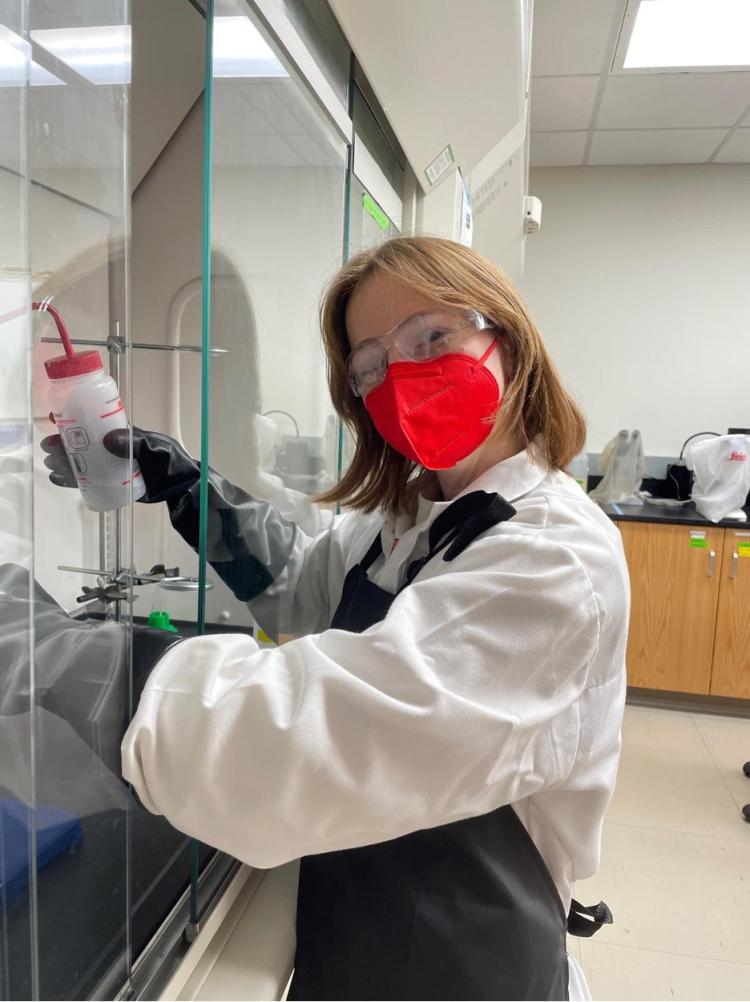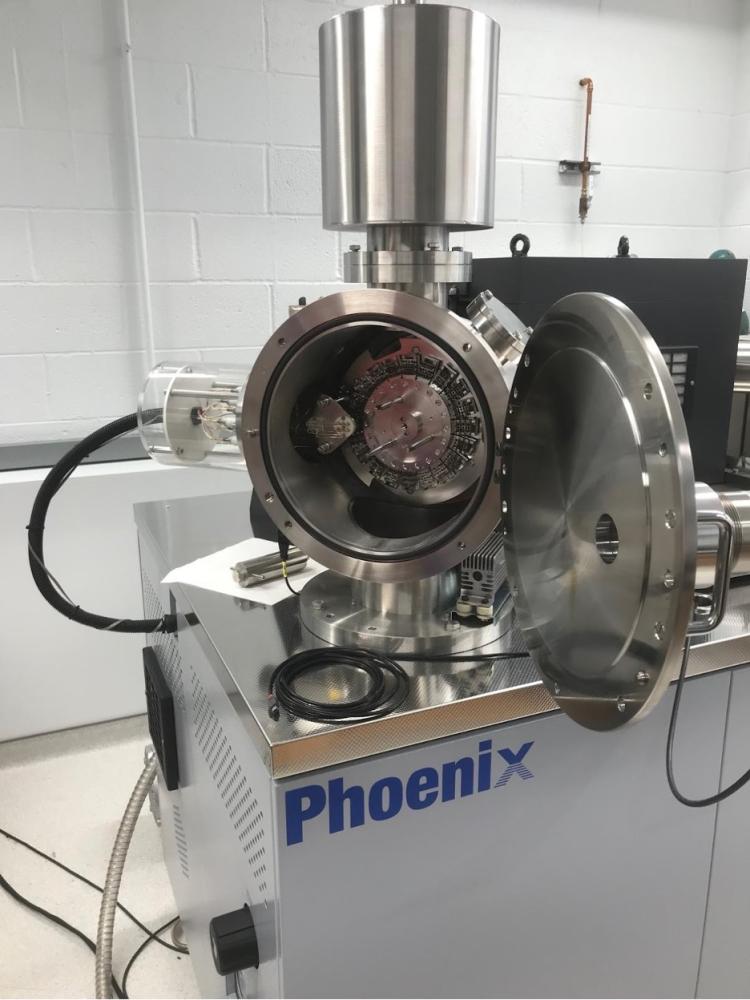Mary Lonsdale - Project Profile
2020 AGeS awardee
Lab: Princeton TIMS Laboratory
Lab Mentors: Blair Schoene
What scientific question(s) does your research address and what motivates this work?
Vase-shaped microfossils (VSMs) occupy a narrow range in the fossil record, with identifiable taxa appearing late in the Tonian Period (ca. 1000-720 Ma) and disappearing near the onset of the Cryogenian Period (ca. 720-635 Ma; Strauss et al., 2014). Despite the brevity of their appearance, VSMs are globally abundant and diverse. VSMs also exhibit early evidence of eukaryovory, as well as inform the timing of the divergence of Amoebozoa (Porter, 2011; Porter et al., 2003). Uncertainty surrounding the timing and conditions of VSM appearance and disappearance inhibit understanding of their evolutionary history. Due to a general paucity of radiometric age constraints, their range of appearance is imprecisely constrained by litho- and chemo-stratigraphy (Riedman and Sadler, 2018). Additional uncertainty regarding the context of VSMs stems from academic dispute over VSM paleoenvironmental context (e.g. Elston, 1989; Dehler et al., 2001). Currently, although VSMs are well-positioned to provide further insight into the evolutionary history of eukaryotes during the Tonian Period, they lack the necessary precise age constraints and paleoenvironmental context. This AGeS project aims to contribute to the temporal context of the appearance of VSMs and address the question: when did VSMs appear in southern Kazakhstan?
What chronometric tool did you employ and why?
In southern Kazakhstan, tuffaceous, zircon-bearing horizons occur among fossiliferous Tonian strata (Sergeev and Schopf, 2010). We leverage this stratigraphic relationship and employ high-precision chemical abrasion-isotope dilution-thermal ionization mass spectrometry (CA-ID-TIMS) U-Pb zircon geochronology to refine existing LA-ICPMS U-Pb zircon ages assigned to rhyolitic tuffs (Levashova et al., 2011). In doing so, we develop age constraints for underlying fossil appearances. CA-ID-TIMS U-Pb zircon geochronology excels at the calibration of the stratigraphic record, as it has a very high analytical precision. Relatively recent innovations of chemical abrasion following annealing of zircons, as well as the practice of CL imagining, effectively addresses issues of Pb-loss and mixing of age domains, permitting the refinement of previously reported LA-ICPMS U-Pb zircon ages from southern Kazakhstan (Levashova et al., 2011).

Figure 1: Prior to CA-ID-TIMS analyses, we must separate zircons from other minerals within our sample. Here, I am pictured performing density separation of zircons at my home institution, Johns Hopkins University.
What were some of the key takeaways of your research?
- We obtain a high-precision CA-ID-TIMS U-Pb zircon age that temporally constrains basal strata from the Kurgan Formation of southern Kazakhstan, which overlie the VSM-bearing Chichkan Formation.
- Our new age agrees with and further refines a previously-reported LA-ICPMS U-Pb zircon age of 766.4 ± 7.2 Ma (Levashova et al., 2011).
- These data, when integrated with the paleontological findings of Sergeev and Schopf (2010), tighten the first appearance datum of common VSM species.
What new experiences, opportunities, and collaborations did you gain as an AGeS-Grad awardee?
For this AGeS project, I brought a sample through all the steps required for CA-ID-TIMS U-Pb zircon geochronology, from mineral separation to data reduction. As a stratigrapher, I understand the immense need for precise radiometric age constraints through geologic time. However, as an AGeS awardee, I now have an appreciation of all of the work that goes into obtaining those much-desired ages, as well as a deeper understanding of the theories and techniques behind CA-ID-TIMS U-Pb zircon geochronology. Additionally, through this project, I was able to establish new collaborations and learn about the chronometer and techniques I was employing for my first time from experts in the field.
What is one piece of advice you have for future AGeS-Grad award applicants or awardees?
I advise any students interested in the AGeS-Grad award to reach out to potential collaborators and discuss project ideas throughout the process. Keeping an open line of communication can only help you learn and further your research.

Figure 2: We analyzed samples on a Phoenix TIMS, pictured here. Samples are loaded onto filaments, placed onto a carousel, and ionized so that they may be measured by the instrument.
References:
Dehler, C.M., Elrick, M., Karlstrom, K.E., Smith, G.A., Crossey, L.J., and Timmons, J.M., 2001, Neoproterozoic Chuar Group (∼800–742 Ma), Grand Canyon: a record of cyclic marine deposition during global cooling and supercontinent rifting: Sedimentary Geology, v. 141–142, p. 465–499, doi:10.1016/S0037-0738(01)00087-2.
Elston, D.P., 1989, Middle and late Proterozoic Grand Canyon Supergroup, Arizona, in Elston, D.P., Billingsley, G.H., and Young, R.A. , eds., Geology of the Grand Canyon, Northern Arizona (with Colorado River Guides): Lee Ferry to Pierce Ferry, Arizona, Washington, D.C., American Geophysical Union, p. 94–105.
Levashova, N.M., Meert, J.G., Gibsher, A.S., Grice, W.C., and Bazhenov, M.L., 2011, The origin of microcontinents in the Central Asian Orogenic Belt: Constraints from paleomagnetism and geochronology: Precambrian Research, v. 185, p. 37–54, doi:10.1016/J.PRECAMRES.2010.12.001.
Porter, S.M., 2011, The rise of predators: Geology, v. 39, 607-608.
Porter, S.M., Meisterfeld, R., and Knoll, A.H., 2003, vase-shaped microfossils from the Neoproterozoic Chuar Group, Grand Canyon: a classification guided by modern testate amoebae: journal of paleontology, v. 77, p. 409–429, doi:10.1666/0022-3360(2003)077<0409:vmftnc>2.0.co;2.
Riedman, L. A., and Sadler, P. M., 2018, Global species richness record and biostratigraphic
potential of early to middle Neoproterozoic eukaryote fossils: Precambrian Research, v. 319, p. 6-18.
Sergeev, V.N., and Schopf, J.W., 2010, Taxonomy, Paleoecology and Biostratigraphy of the Late Neoproterozoic Chichkan Microbiota of South Kazakhstan: The Marine Biosphere on the Eve of Metazoan Radiation: Journal of Paleontology, v. 84, p. 363–401, doi:10.1666/09-133.1.
Strauss, J. V., Rooney, A.D., Macdonald, F.A., Brandon, A.D., and Knoll, A.H., 2014, 740 Ma vase-shaped microfossils from Yukon, Canada: Implications for Neoproterozoic chronology and biostratigraphy: Geology, v. 42, p. 659–662, doi:10.1130/G35736.1.

